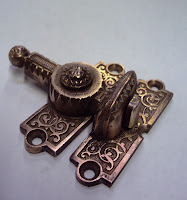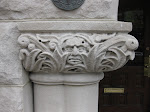Here at WEI, w
 e do quite a lot of window restoration. We are currently working on some double- hung windows from a residence in the Bolton Hill neighborhood of Baltimore. Like the entire house, the windows are fantastic. They are typical weighted double hungs, however they include leaded glass transoms. Three of these windows are portraits of unknown women. We are cleaning all of the transoms and repairing damage to the lead caming and the glass. They are heavily coated on the interior with dirt, tar and creosote. We are gently cleaning them with detergent and water.
e do quite a lot of window restoration. We are currently working on some double- hung windows from a residence in the Bolton Hill neighborhood of Baltimore. Like the entire house, the windows are fantastic. They are typical weighted double hungs, however they include leaded glass transoms. Three of these windows are portraits of unknown women. We are cleaning all of the transoms and repairing damage to the lead caming and the glass. They are heavily coated on the interior with dirt, tar and creosote. We are gently cleaning them with detergent and water. While the house dates to the 1860's-70's, we don't have a specific date for the windows themselves. The patent date on the sash locks is 1869. This only proves that the locks weren't in the house until then. It is possible that the leaded transoms were added after the house was constructed. There were several merchants providing glass in Baltimore at this time, the largest of which were Baker & Brother on S. Charles St., Hugh Bolton on McElderry's Wharf and Otis Keilhotz on Franklin St. Any of these companies could have provided this glass to the property owners.
While the house dates to the 1860's-70's, we don't have a specific date for the windows themselves. The patent date on the sash locks is 1869. This only proves that the locks weren't in the house until then. It is possible that the leaded transoms were added after the house was constructed. There were several merchants providing glass in Baltimore at this time, the largest of which were Baker & Brother on S. Charles St., Hugh Bolton on McElderry's Wharf and Otis Keilhotz on Franklin St. Any of these companies could have provided this glass to the property owners.
Part of t
 he enjoyment of this work is discovering the people that built the property in the first place. The merchants, such as Baker & Brother, the manufacturer's such as Hopkins & Dickinson, who made the sash lock, and the craftsm
he enjoyment of this work is discovering the people that built the property in the first place. The merchants, such as Baker & Brother, the manufacturer's such as Hopkins & Dickinson, who made the sash lock, and the craftsm en, such as Harry Dennis, who worked for Benjamin M. Dennis as a paperhanger and scrawled graffiti on an interior wall before papering over it. Baltimore was quite the town in the 19th century, full of successful entrepreneurs and immigrants. It was growing at an impressive rate and rivaled New York and Philadelphia. By the end of the century it was home to a championship baseball team! As the city grew, thousands of men in the building trades built these spectacular buildings. Their names are largely forgotten, but by restoring their work we can, in a small way, bring them back to life.
en, such as Harry Dennis, who worked for Benjamin M. Dennis as a paperhanger and scrawled graffiti on an interior wall before papering over it. Baltimore was quite the town in the 19th century, full of successful entrepreneurs and immigrants. It was growing at an impressive rate and rivaled New York and Philadelphia. By the end of the century it was home to a championship baseball team! As the city grew, thousands of men in the building trades built these spectacular buildings. Their names are largely forgotten, but by restoring their work we can, in a small way, bring them back to life.
Baker & Brother Advertisment used with the permission of the Maryland State Archives:
SPECIAL COLLECTIONS (Baltimore City Directories Collection)John W. Woods, Wood's Baltimore Directory for 1856-'57, Baltimore, 1856, available on line at http://archivesofmaryland.net/



